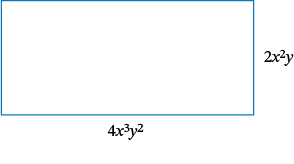
Hello! Welcome to this video on multiplying monomials.
Remember, a monomial is a mathematical expression that only has one term. Some examples of monomials are \(2x\), \(4y^{3}\), and \(7x^{2}y\).
Notice that monomials can have coefficients, multiple variables, and the variables can be raised to different exponents. As long as all these things are multiplied by one another, you still have a monomial.
Example #1
Let’s start by multiplying two simple monomials.
When multiplying monomials, first multiply the coefficients. So the coefficients in this problem are 2 and 3, so we’ll have:
Then, multiply the variables, so in this case, we have:
Now, all you have to do is put these two parts together.
Not too challenging, right?
Example #2
Let’s try another one!
First, multiply the coefficients.
Then, multiply the variables. Remember, when multiplying variables raised to exponents, add the exponent values together.
Now, put these two things together.
Example #3
Let’s try a slightly harder example.
Don’t be confused by the variables \(a\) and \(b\). They are just different letters used for the variables, so treat them just like you would an \(x\) and a \(y\). First, multiply the coefficients together.
With this example, we have two different variables, so let’s work through them one at a time. First, multiply the \(a\)’s.
Now we’re going to multiply our \(b\)’s together.
Finally, put all three parts together.
Before we go, I want to try one last example together.
First, multiply the coefficients together.
Then, multiply the \(x\)’s by each other.
Next, multiply the \(y\)’s by each other.
Finally, put all three parts together.
And that’s all there is to it!
I hope this video on multiplying monomials made the topic seem a little less intimidating. Thanks for watching, and happy studying!
Multiplying Monomials Practice Questions
Multiply \(5y^2\cdot 4y^4\).
Use the properties of exponents when multiplying monomials.
When multiplying two or more monomials, multiply their coefficients first.
\(5×4=20\)
Now, multiply the variables of the two terms by adding their exponents.
\(y^2\cdot y^4=y^{2+4}=y^6\)
Lastly, write the products and variables as one term.
\(5y^2\cdot 4y^4=20y^6\)
Multiply \(6x^2y^3\cdot 7x^2 y^5\).
Use the properties of exponents when multiplying monomials.
When multiplying two or more monomials, multiply their coefficients first.
\(6×7=42\)
Now, multiply the variables of the two terms by adding the exponents. Multiply the \(x\)-variables.
\(x^2\cdot x^2=x^{2+2}=x^4\)
Multiply the \(y\)-variables.
\(y^3\cdot y^5=y^{3+5}=y^8\)
Lastly, write the products and variables as one term.
\(6x^2 y^3\cdot 7x^2 y^5=42x^4 y^8\)
Multiply \(3pq^4(-6p^2q^5)\).
Use the properties of exponents when multiplying monomials.
When multiplying two or more monomials, multiply their coefficients first.
\(3×(-6)=-18\)
Now, multiply the variables of the two terms by adding the exponents of like bases. Multiply the \(p\)-variables.
\(p\cdot p^2=p^1\cdot p^2=p^{1+2}=p^3\)
Multiply the q-variables.
\(q^4\cdot q^5=q^{4+5}=q^9\)
Lastly, write the products and variables as one term.
\(3pq^4(-6p^2 q^5)=-18p^3 q^9\)
Find the area of the rectangle below with the given monomial dimensions in terms of \(x\) and \(y\).

The formula for the area of a rectangle is:
\(A=l×w\)
where \(l\) is the length and \(w\) is the width of the rectangle.
Substitute the length of \(4x^3y^2\) and the width of \(2x^2y\) into the area formula.
\(A=4x^3 y^2×2x^2 y\)
Use the properties of exponents when multiplying monomials.
When multiplying two or more monomials, multiply their coefficients first.
\(4×2=8\)
Now, multiply the variables of the two terms by adding the exponents of like bases. Multiply the \(x\)-variables.
\(x^3\cdot x^2=x^{3+2}=x^5\)
Multiply the y-variables.
\(y^2\cdot y=y^2\cdot y^1=y^{2+1}=y^3\)
Lastly, put the products of the coefficients and the variable terms together.
\(4x^3 y^2×2x^2 y=8x^5 y^3\)
So, the area of the rectangle is \(8x^5 y^3\) square units.
A major department store chain sold \(6a^2 b^3\) phone chargers last week for \(a^3 b^4\) dollars. What is the total revenue generated, in dollars, by the sales of the phone chargers last week for the department store chain in terms of \(a\) and \(b\)?
Total revenue is the product of the price of a unit sold and the number of units sold. So, the total revenue generated by the sales of the phone chargers is:
\(\text{Total Revenue}=\text{(Price)(Units Sold)}\)
\(\text{Total Revenue}=a^3 b^4\cdot 6a^2 b^3\)
Use the properties of exponents when multiplying monomials.
When multiplying two or more monomials, multiply their coefficients first. The monomial \(a^3 b^4\) can be written as \(1a^3 b^4\), so its coefficient is 1.
\(1×6=6\)
Now, multiply the variables of the two terms by adding the exponents of like bases. Multiply the \(x\)-variables.
\(a^3\cdot a^2=a^{3+2}=a^5\)
Multiply the y-variables.
\(b^4\cdot b^3=b^{4+3}=b^7\)
Lastly, write the products and variables as one term.
\(a^3 b^4\cdot 6a^2 b^3 = 6a^5 b^7\)
So, the revenue generated by the sales of the phone chargers for the week was \(6a^5 b^7\) dollars.
